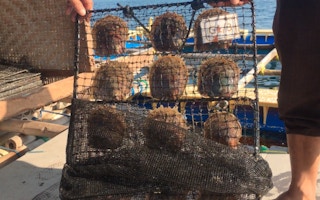In the waters off Bali’s northern coast, three men stand atop a floating cage that holds thousands of pearl oysters.
In 2016, they were hired by the oyster fisheries agency in Bali’s Karangasem district to cultivate Pinctada maxima pearl oysters, the mollusks famous for producing South Sea pearls, prized for their use in jewelry.
The cage in Sumberkima, measuring 48 square meters (517 square feet) is only the beginning of an effort to establish a new Indonesian center for pearl farming in Bali. In the long run, the program is also meant to maintain Indonesia’s position as the world’s biggest producer of South Sea pearls. Forty-three per cent of the world’s supply comes from the Southeast Asian country, according to government data.
Pearling has a long history in Indonesia. For centuries, villagers in the eastern Indonesian archipelago of Aru, for example, have dived for pearls to sell to traders.
“
Pearl oyster farming and breeding is our hope to provide good-quality pearls and stop exploitation of the oysters in the wild.
Ngurah Sedana Yasa, researcher, Karangasem Oyster Fisheries Agency
The pearl farming industry really got off the ground when Japanese companies began to operate in Sulawesi, according to Ngurah Sedana Yasa, a researcher at the Karangasem oyster fisheries agency, who leads the program in Sumberkima. It then spread to other parts of the country, including West Nusa Tenggara, the Maluku Islands, West Papua and Lampung.
In 2016, Indonesia earned $15.2 million from exporting South Sea pearls, mostly to Japan.
But the industry’s fast growth has taken a toll on wild oyster populations. There’s also been a decline in the quality of pearls.
In response, Indonesia launched a pearl oyster breeding initiative, from where the Sumberkima program got its start.
“The most crucial thing is finding the perfect site for the pearl farm,” Sedana said.
Sumberkima is an ideal fit. Barrier reefs along the coast make for calm waters, lowering the chances of juvenile oysters being swept away by the current.
Since Sumberkima is already home to several fish farms, the waters are rich with phytoplankton, which the oysters feed on.
“Once we get the perfect site, raising the oysters doesn’t require much daily work,” Sedana said.
The floating cage in Sumberkima is managed by three men, including Jumari, 45.
“We used to work in a shrimp nursery until we learned about the program,” he said as he placed hundreds of baby oysters into the cage via a several large sheets.
Once the baby oysters, bred by the agency in Karangasem, are placed in the cage, Jumari and his colleagues tend to them once every week or two, ensuring they’re protected from crabs and other predators.
The agency wants to expand the program across Bali’s northern coast, where the waters are generally calm and free of predators.
“Unfortunately, not all waters in Indonesia are suitable for pearl oyster farming,” Sedana said. “Even after we find a perfect site, we still have to deal with other interests. In Bali, for example, we have to compete with tourism.”
If the breeding program results in enough high-quality pearl oysters, Sedana said it could help reduce the industry’s reliance on wild oysters.
P. maxima isn’t a protected species under the Indonesian Conservation Act and, according to Sedana, there isn’t a limited quota set by the government to protect them from unsustainable collection in the wild. However, the Indonesian Ministry of Maritime Affairs and Fisheries has issued a decree to ban the export of germplasm of a number of marine life, including pearl oysters, in an effort to tackle foreign biopiracy in Indonesia.
“Pearl oyster farming and breeding is our hope to provide good-quality pearls and stop exploitation of the oysters in the wild,” Sedana said.
This story was published with permission from Mongabay.com










